
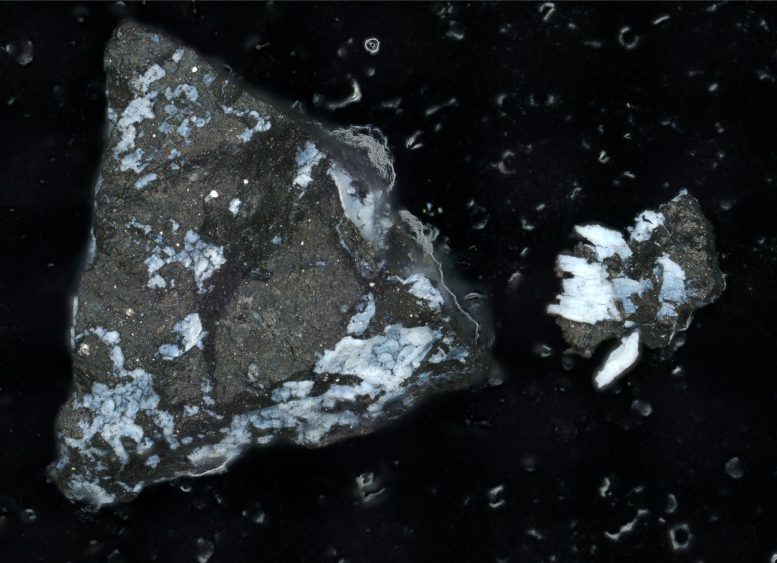
Micrograph of a dark Bennu-type object, about one millimeter long, with a bright phosphate shell. On the right is a smaller fragment that has broken off. Image credit: Lauretta & Connolly et al. (2024) Meteorology and Planetary Sciencedoi:10.1111/maps.14227
Analysis of a sample from the asteroid Bennu has revealed the presence of key ingredients for life and signs of a watery past, providing insights into the origins of the solar system and biochemistry.
- Early analysis of the asteroid Bennu sample returned by NASA‘s Osiris-Rex The mission revealed dust rich in carbon, nitrogen and organic compounds, all essential ingredients for life as we know it. The sample, dominated by clay minerals, especially serpentine, reflects the type of rocks found in Earth’s mid-ocean ridges.
- Magnesium and sodium phosphates found in the sample suggest that the asteroid may have broken away from a small, primitive ancient ocean world. The phosphates were a surprise to the team because the mineral had not been detected by the OSIRIS-REx spacecraft while it was at Bennu.
- While similar phosphate was found in the Ryugu asteroid sample delivered by Japan Aerospace Exploration AgencyOn the Japan Aerospace Exploration Agency’s Hayabusa2 mission in 2020, magnesium sodium phosphates detected in the Bennu sample were notable for their purity (i.e., the absence of other materials included in the mineral) and grain size, unprecedented in any meteorite sample.
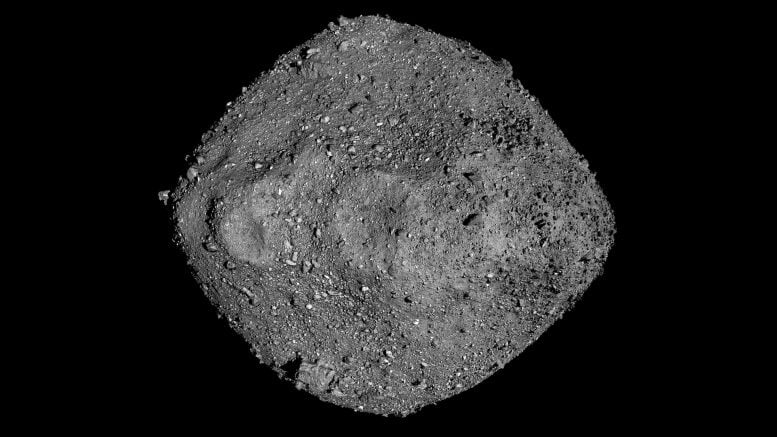
This mosaic of Bennu was created using observations made by NASA’s OSIRIS-REx spacecraft, which has been close to the asteroid for more than two years. Credit: NASA/Goddard/University of Arizona
Discoveries from the composition of the asteroid Bennu
Scientists have been eagerly awaiting the chance to dig into the pristine 4.3-ounce (121.6-gram) Bennu asteroid sample collected by NASA’s OSIRIS-REx (Origins, Spectral Interpretation, Resource Identification, and Security—Regolith Explorer) mission since it was delivered to Earth last fall. They hoped the material might hold secrets about the solar system’s past and the biochemistry that may have led to the origin of life on Earth. An early analysis of the Bennu sample, published recently in the journal Meteorology and Planetary Scienceindicating that this excitement was justified.
The OSIRIS-REx sample analysis team found that the asteroid Bennu contains the original ingredients that formed our solar system. The asteroid dust is rich in carbon and nitrogen, as well as organic compounds, all of which are essential ingredients for life as we know it. The sample also contains magnesium and sodium phosphate, which surprised the research team because it had not been seen in the remote sensing data the spacecraft collected on Bennu. Its presence in the sample suggests that the asteroid may have broken off from a small, primitive ocean world that has long since disappeared.
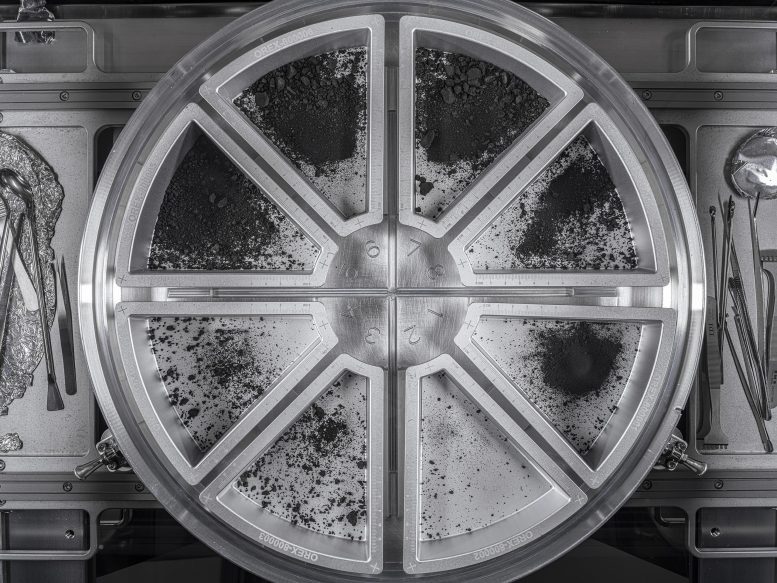
A view of eight sample trays containing the final material from asteroid Bennu. Dust and rock were poured into the trays from the top plate of the Touch and Go Sample Collection Mechanism (TAGSAM) head. 51.2 grams were collected from this pour, giving the final mass of the asteroid sample 121.6 grams. Credit: NASA/Erica Blumenfeld and Joseph Aebersold
Analysis of a sample from the asteroid Bennu has revealed intriguing insights into the composition of the asteroid. The sample, which is dominated by clay minerals, particularly serpentine, reflects the type of rock found in Earth’s mid-ocean ridges, where material from the mantle, the layer beneath Earth’s crust, meets water.
This reaction not only creates clay, but also a variety of minerals such as carbonates, iron oxides, and iron sulfides. But the most surprising discovery is the presence of water-soluble phosphates. These compounds are the biochemical components of all known life on Earth today.
While similar phosphate was found in the Ryugu asteroid sample sent back by the Japan Aerospace Exploration Agency (JAXA) Hayabusa2 mission in 2020, the magnesium-sodium phosphate detected in the Bennu sample stands out for its purity — the absence of other materials in the mineral — and its grain size, which is unprecedented in any meteorite sample.
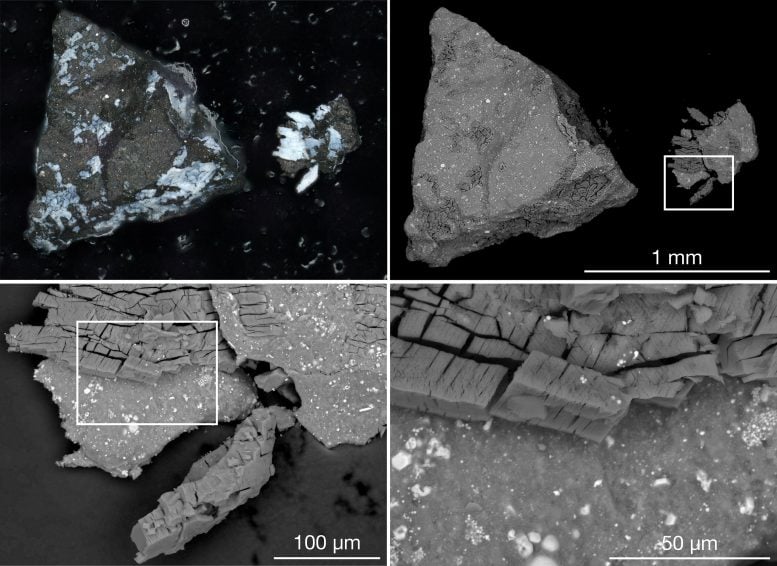
A small portion of the Bennu asteroid sample returned by NASA’s OSIRIS-REx mission, as seen in microscope images. The upper left panel shows a dark Bennu particle, about 1 millimeter long, with a bright phosphate outer shell. The other three panels show progressively enlarged images of a fragment of the particle that broke off along a bright phosphate vein, captured by a scanning electron microscope. Copyright: Lauretta & Connolly et al. (2024) Meteorology and Planetary Sciencedoi:10.1111/maps.14227
The finding of magnesium and sodium phosphates in the Bennu sample raises questions about the geochemical processes that concentrated these elements, and provides valuable clues about Bennu’s historical conditions.
“The presence and condition of phosphate, along with other elements and compounds on Bennu, suggests a watery past for the asteroid,” said Dante Lauretta, co-lead author of the study and principal investigator for the OSIRIS-REx program at the University of Arizona in Tucson. “It is possible that Bennu was once part of a wetter world, although this hypothesis requires further investigation.”
“OSIRIS-REx has given us exactly what we were hoping for: a large, pristine asteroid sample rich in nitrogen and carbon from a once-wet world,” said Jason Durkin, a co-author of the study and OSIRIS-REx project scientist at NASA’s Goddard Space Flight Center in Greenbelt, Maryland.
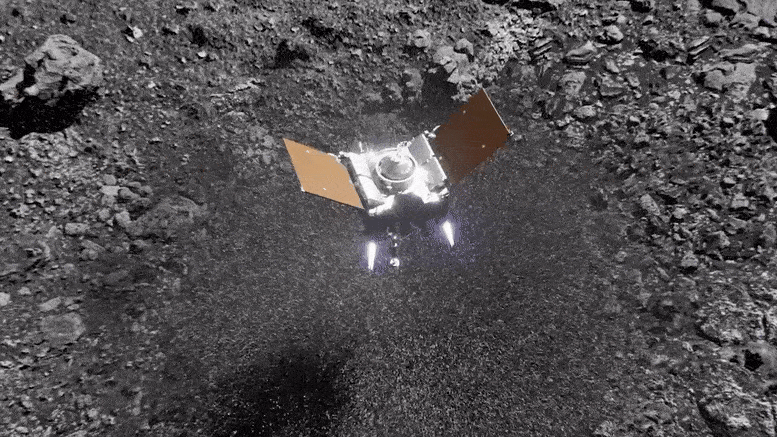
NASA’s OSIRIS-REx spacecraft leaves the surface of asteroid Bennu after collecting a sample. Image credit: NASA’s Goddard Space Flight Center/CI/SVS Laboratory
Despite its possible history of interaction with water, Bennu remains a chemically primitive asteroid, with elemental ratios very similar to those of the Sun.
“The sample we returned is the largest reservoir of unaltered asteroid material currently on Earth,” Lauretta said.
This formation offers a glimpse into the early days of our solar system, more than 4.5 billion years ago. These rocks have retained their original state, and have not melted or re-solidified since their formation, confirming their ancient origins.
The team confirmed that the asteroid is rich in carbon and nitrogen. These elements are essential for understanding the environments in which Bennu’s materials originated and the chemical processes that transformed simple elements into complex molecules, which may lay the foundation for life on Earth.
“These results underscore the importance of collecting and studying materials from asteroids like Bennu — particularly the low-density materials that typically burn up as they enter Earth’s atmosphere,” Lauretta said. “These materials hold the key to unraveling the complex processes of solar system formation and the biochemistry that may have contributed to the emergence of life on Earth.”
Dozens of other laboratories in the United States and around the world will receive portions of Bennu sample from NASA’s Johnson Space Center in Houston in the coming months, and more scientific papers describing Bennu sample analyses are expected in the next few years from the OSIRIS-REx Sample Analysis Team.
“The Bennu samples are stunningly beautiful exoplanetary rocks,” said Harold Connolly, co-lead author of the study and OSIRIS-REx sample scientist at Rowan University in Glassboro, New Jersey. “Every week, the OSIRIS-REx sample analysis team provides new and sometimes surprising results that help place important constraints on the origin and evolution of Earth-like planets.”
The OSIRIS-REx spacecraft launched on September 8, 2016, traveled to the near-Earth asteroid Bennu and collected a sample of rock and dust from the surface. OSIRIS-REx, the first American mission to collect a sample from an asteroid, delivered the sample to Earth on September 24, 2023.
Reference: “Asteroid (101955) Bennu in the Laboratory: Characterization of the Sample Collected by the OSIRIS-REx Spacecraft” by Dante S. Lauretta, Harold C. Connolly, Joseph E. Aebersold, Connell M. O. D. Alexander, Ronald L. Ballouz, Jessica J. Barnes, Helena C. Bates, Carina A. Bennett, Laurinne Blanche, Erika H. Blumenfeld, Simon J. Clemett, George D. Cody, Daniella N. DellaGiustina, Jason P. Dworkin, Scott A. Eckley, Dionysis I. Foustoukos, Ian A. Franchi, Daniel P. Glavin, Richard C. Greenwood, Pierre Haenecourt, Victoria E. Hamilton, Dolores H. Hill, Takahiro Hiroi, Kana Ishimaru, Fred Jourdan, Hannah H. Kaplan, Lindsay P. Keller, Ashley J. King, Piers Koefoed, Melissa K. Kontogiannis, Loan Le, Robert J. Macke, Timothy J. McCoy, Ralph E. Milliken, Jens Najorka, Ann N. Nguyen, Maurizio Pajola, Anjani T. Polit, Kevin Reiter,Heather L. Roper, Sarah S. Russell, Andrew J. Ryan, Scott A. Sandford, Paul F. Scofield, Cody D. Schultz, Laura B. Seifert, Shogo Tachibana, Cathy L. Thomas-Kiberta, Michelle S. Thompson, Valerie Tu, Filippo Tosperti, Kun Wang, Thomas J. Zega, C. W. V. Woolner, June 26, 2024, Meteorology and Planetary Science.
DOI: 10.1111/maps.14227
NASA’s Goddard Space Flight Center in Greenbelt, Maryland, provided overall mission management, systems engineering, safety and mission assurance for OSIRIS-REx. Dante Lauretta of the University of Arizona, Tucson, is the principal investigator. The university leads the science team and the mission’s science observation planning and data processing. Lockheed Martin Space in Littleton, Colorado, built the spacecraft and provided flight operations. Goddard and Kinetics Aerospace were responsible for the direction of the OSIRIS-REx spacecraft. OSIRIS-REx is organized at NASA Johnson. International partnerships on the mission include the Canadian Space Agency’s OSIRIS-REx laser altimeter and a scientific collaboration on asteroid samples with the Japan Aerospace Exploration Agency’s Hayabusa2 mission. OSIRIS-REx is the third mission in NASA’s New Frontiers Program, which is managed by NASA’s Marshall Space Flight Center in Huntsville, Alabama, for the agency’s Science Mission Directorate in Washington.

“Web maven. Infuriatingly humble beer geek. Bacon fanatic. Typical creator. Music expert.”





More Stories
SpaceX launches 23 Starlink satellites from Florida (video and photos)
A new 3D map reveals strange, glowing filaments surrounding the supernova
Astronomers are waiting for the zombie star to rise again